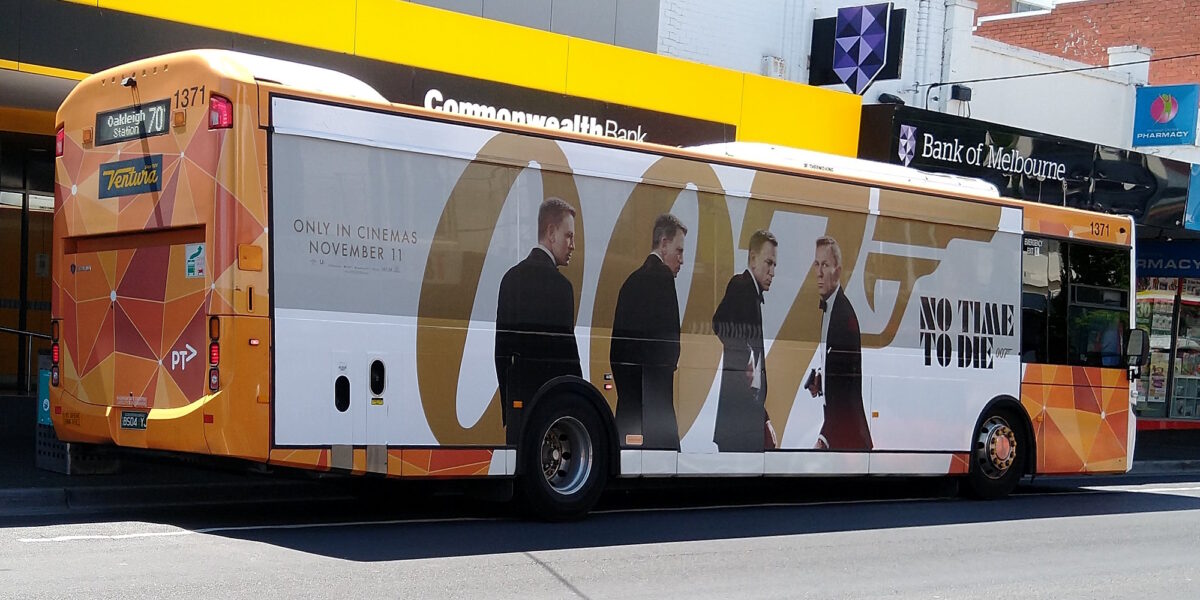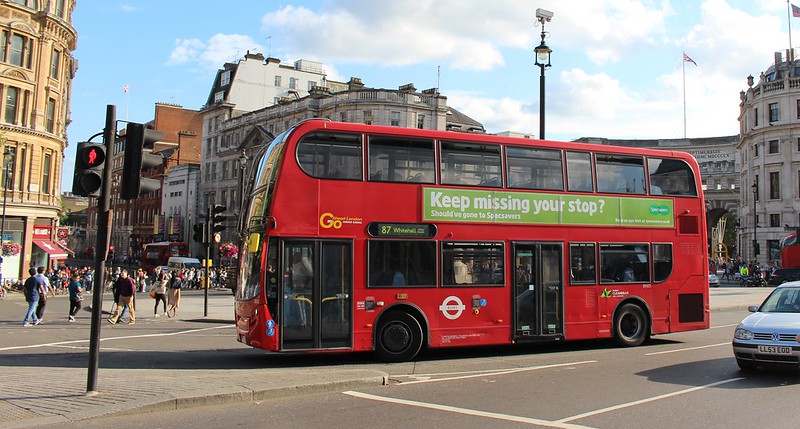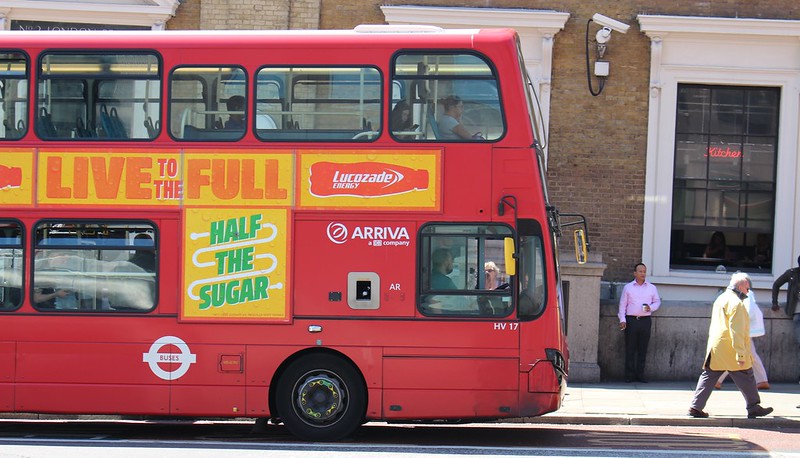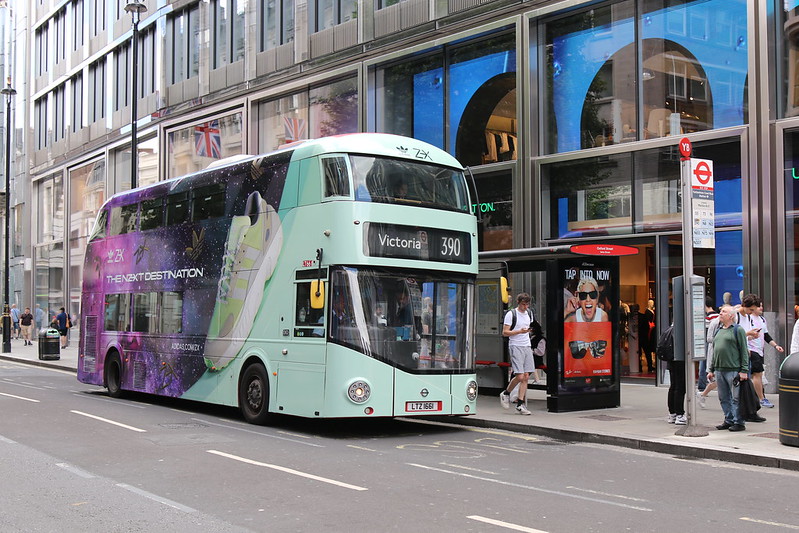Advertising on public transport is big business, and the revenue it brings in helps subsidise the system.
For advertisers who want to pay the big bucks, All-Over Advertising, or wraps, are the go. A chance to completely brand the vehicle in your colours. These cost tens of thousands of dollars.
But wraps brings problems, especially when ads cover the windows, as it reduces visibility for people looking in and out. Is this my stop? Where am I? Is this part of the train crowded? Should I go to the next door or carriage?
And of course it’s even worse for people with vision difficulties.
What are the rules?
On Metro trains, window ads were previously used, but thankfully have been prohibited under the current operator contracts.
But V/Line still sometimes uses them on their fleet. Good message; bad placement.
On trams, a read of the contracts (“Passenger Experience Module”) notes advertising restrictions on W-class and City Circle trams. It also mentions a “cap on the percentage of fleet that can be the subject of advertising wraps”, without specifying what that percentage is.
This page from JCDecaux indicates it’s 10% of the fleet. Not that it helps if the specific tram you’re catching has ads all over the windows.
It’s not publicly available, but there’s a fleet Master Style Guide which presumably determines precisely where the ads can go. In the case of wraps, a few windows have to be left uncovered – but not most of them.
At one stage the older trams only got ads along the roof and under the windows. Not any more – all classes except the Ws now get ads on windows, including this “Safety you can see” design from a couple of years ago, showing a complete lack of self-awareness from the designers.
And for buses? The rules are unclear, and it possibly varies between operators. The old Transdev contract is still online, and mentions limitations on the Smartbus fleet, and they also have a Master Style Guide, but again, it’s not public.
Bus ads: Melbourne vs London
I thought it would be interesting to compare Melbourne with a city that genuinely cares about and invests in its buses: London.
Here’s a Melbourne bus with a small amount of advertising; pretty typical.
The ad is designed in portrait orientation, so it blocks some windows (as does the Clean Energy signage), but not most.
Here’s a London bus with a small amount of advertising. No windows blocked at all on the left hand side.
And on the other side of the buses, they’re designed to use the space taken up by the windowless stairwell. Clever.
Here’s what bus wraps look like in Melbourne. Every bit of window covered, except at the front near the driver. Is it public transport, or a mobile billboard?
And here’s a London bus with an advertising wrap. Notice the difference?
Mostly they avoid covering the windows. Just a bit near the front, including (on the New Routemaster “Boris Buses”) the stairwell.
Even for the Queen’s Platinum Jubilee, they refrained from covering the windows.
And as you can see from these other London examples, this is pretty standard. They focus on making the bus eye-catching thanks to its non-standard colour, and some clever design to highlight the message, but mostly leave the windows alone.
One final comparison: Bond in London vs Melbourne.
The contrast is clear. Using the same artwork, in Melbourne they just cover over the windows with pictures, letters or a white background; in London they are clever and mostly avoid it.
We could do better
Ultimately, covering the windows reduces visibility, and shows a lack of respect for passengers.
There has been resistance. Back in 2017 there was a short-lived guerrilla campaign against tram ads.
Melbourne’s buses are mostly single deck, but both buses and trams still have a fair bit of available space apart from the windows.
As the photos from London show, if they were smarter about the designs of the ads, even without the benefit of the bigger canvas of double decker buses, they could get their messages across while not impacting passengers so badly.
If they can’t cover the windows from November, they can use the ad spaces along the roofline again. Easy! pic.twitter.com/5zDBxuQx2s
— Daniel Bowen (@danielbowen) September 13, 2017
It’s good that ads over windows are prohibited on metro trains. They should make sure to keep that in the upcoming contracts.
Bus contracts have varying expiry dates (and a big one for Kinetic only started recently).
There’s an opportunity to fix this on Melbourne’s trams. The current “MR4” contract expires in 2024 (with a possible 3 year extension).
If the government wants, they could push for better outcomes for passengers: better ad designs, with fewer windows covered up.









16 replies on “The cover-up: ads on windows”
I can never get responses to my various complaints about covering windows with advertising. There is barely a D1 class tram now without advertising. Two of four best seats in a B class tram have windows with advertising on them. The rear of a number of buses are covered and they are so dark inside. Public transport users would be so pleased if 2017 mob who worked for the betterment of society could find a spray on solvent to destroy the advertising.
I have screenshots of every tram and more than half of the C1, C2, D1 and D2 fleets have full wraps, although which ones are wrapped may vary from time to time. For D1 22 of 38 have wraps, including 2 Art Trams. None of the E-Class have wraps other than the Made in Melbourne decals.
I am also not a fan of blocking out the front left passenger interior glass (i.e. the one to prevent passengers flying forward in sudden braking) with a generic sticker e.g. reminding passengers to touch on. It means you can’t see out the front of the bus.
Perhaps a possible solution is to ensure that the printing over the windows is very close to transparent (about 10% on the alpha channel)? The advertiser still gets a ‘wrap’, vehicle owners get their income, and users get to see out properly. Should this be a PTUA issue?
The London example is pretty typical of Europe generally. Here it’s pretty shocking. In some jurisdictions there is obviously a rule that doors are kept clear so that they are visible. In others, the AOA is run right across the centre and rear doors so that you can’t even see where they are. They know full well that having it over windows creates a visibility issue for passengers, otherwise they wouldn’t be leaving windows and doors around the drivers clear.
The V/Line ones aren’t even real advertising most of the time. I sometimes joke to my work colleagues online while I’m working on the train that I ‘think’ I’m in such-and-such a location but I can’t really see out the window because I’m on the dinosaur/Aboriginal art/etc train.
it *seems* to me that the windows on the london busses are smaller than the ones on the melbourne busses?
so the %age surface area here without windows is much lower (whole wall window compared to smaller windows with ~foot wide metal “gaps”).
this seems likely an input into why they skip the glass in london and dont here?
The Bond ad on the London bus looks so much classier than the same ad on the Melbourne bus — not because it’s British either, but the careful colouring, placement of the ads around windows makes it look so very much better. Of course, that will cost a bit more for design, but if they want to use public spaces, they should be made to fit rather than compromise the safety and accessibility of users.
There is nothing wrong with the current system!
It’s hard enough to see where I am on trams and buses at night, even without the ads. (Trains are generally better considering they actually stop and call all of the stations.) Aside from not having ad wraps all over the vehicles, I wouldn’t mind backlit signs showing the names on at least on major stops.
I was on a Dyson’s rail replacement bus the other day and was seated next to a window that was obviously meant to be covered for the inside – Dyson’s livery with the Dyson’s name – but the name was written to read from the inside!
@Steve – that would be an anti-scratch film applied to the inside of the windows. A few other Melbourne bus operators do the same, this is Transdev.
https://railgallery.wongm.com/bus-bits/F137_6275.jpg.html
Transperth takes it to a whole other extreme, installing steel mesh panels inside the saloon to protect the glass.
https://railgallery.wongm.com/bus-bits/F152_0666.jpg.html
I know with some Transit Systems buses, there is a screen at the front that shows the next five stops. I am not sure if other operators do it (I know CDC Melbourne doesn’t).
On the topic of advertisements on public transport, I agree with the fact that public transport is a public good and that companies who operate public transport needs to be aware of that. But unfortunately, we are living in a commercialised world in which we are basically consumers who are being sold to the advertisers, and today, advertising is everywhere. It is hard to avoid these advertisements. And I remember a couple of times, I have seen Kastoria buses covered in the same advertisement from front to back, which is way overboard. I am not sure if they are still doing it though, so anyone who is in the western suburbs (like around the areas like Moonee Ponds, Watergardens, etc.) can fill me in on the details, that will be appreciated.
V/Line are advertising their app across the windows on this morning’s train. Which might not be all that useful when they’re running the slow train timetable this afternoon. On the positive side, it’s providing some shade from the sun.
[…] no need for this. PT networks and advertisers can work around it if they try. I’d love to see blocking the windows banned on trams and buses, just as it is for […]
[…] Ads covering windows were a big problem on Metro trains. Thankfully since then they’ve been prohibited, but they remain a problem on trams, buses and V/Line. […]